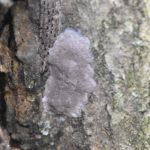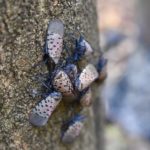
Spotted lanternfly egg mass – photo by A.L. Nielsen
Spotted lanternfly is a new invasive species in NJ. Egg masses are brownish grey and generally laid on bark in early fall and appear like a smudge of mud. Adults are expected to start egg laying in August and continue through November or the first hard frost.
SLF eggs overwinter and can be laid on multiple hard surfaces, including fence posts, trees, patio furniture, fruit bins, landscaping stones, railway cars, etc. Due to this they can be easily transported and represent a significant risk to SLF populations spreading. Vehicles, stones, agricultural equipment, and fruit bins coming from PA or VA should be inspected for egg masses beginning in August. Within state movement is also of concern to prevent new populations. If found, egg masses can be scraped into a plastic bag and frozen to limit spread and future impact of this pest.


